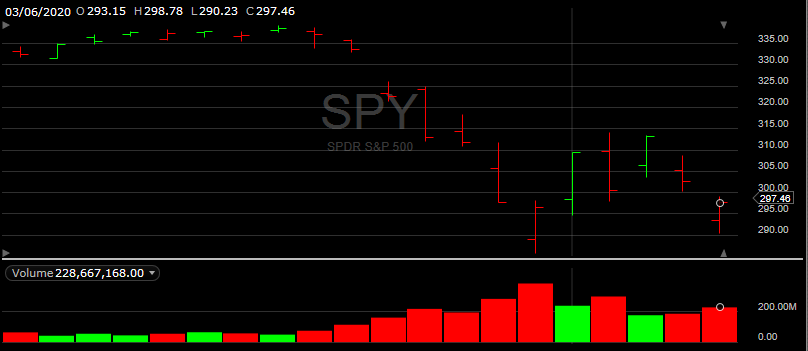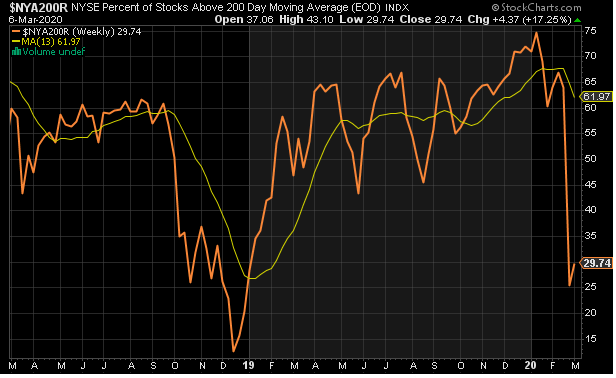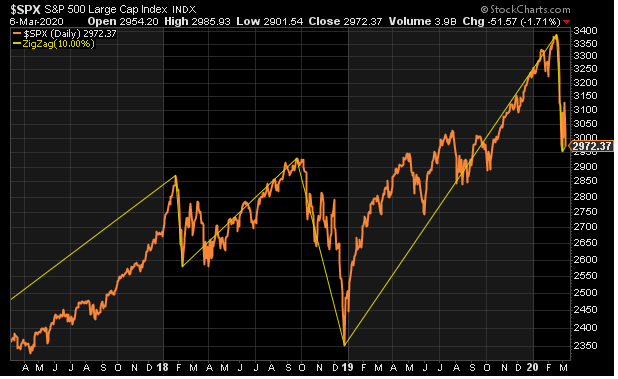What happened last week, and what it may mean for the market in 2020.
Requiem for a Dip-Buyer
That clip from Animal House captures the level of panic we're experiencing with the ever-spreading Covid-19 virus. Up until February 19th, dip-buyers believed that all was well. The 11 year bull market that began on March 9, 2009, had, up until then, been a dip-buyer's paradise. Not any more.
On February 19th the ground shifted and the rally-sellers took control of the stock market. There has been so much damage done to the dip-buyers, to companies that depend on travel & entertainment, and to the global economy that it could take several quarters, if not years, for things to return to normal.
Chart 1. The most recent market action
This chart (Fidelity) covers the most recent month for the S&P 500 index. A couple of things to note.
- On the left side of the chart, as the market was making new highs, volume was relatively low.
- The daily swings from high to low were relatively small.
- After the last new high (the 5th green bar) things began to go south in a hurry. The wheels came off.
- Note the increasing volume on down days, and weaker volume on up days. A lack of buying conviction.
- Fridays are notably more weak than other days, indicating reluctance to hold stocks over the weekend.
- There have been only 4 up days in the last 15. Normally there are 9.
- Conclusion: there has been a seismic shift in the market, with rally-sellers now in control.
Chart 2. Percent of stocks above their 200 Day Moving Average
For the rest of the charts I will use StockCharts.com I don't think this chart needs much explanation. We're approaching the level last seen in December, 2018. The market was down by 19.9% at that time. Today it's only down by 12.2%.
Chart 3. Down Volume Detrended
I like this chart because it does a good job of separating the signal from the noise. In this case we see the spike in down volume after deducting the long term average volume. This market event is worse than December, 2018 from this vantage point.
Chart 4. Third correction in three years
If you're a dip-buyer you probably think corrections aren't a big deal, and normally I would agree with you. But 3 corrections in 3 years is worth noting. It goes to the instability of this market. Will the current correction morph into a proper bear market? I don't know, but it could. In fact, it's more likely than not.
Final Thoughts
The dip buyers of today have shown that they are willing to step in and buy anytime the market has the slightest hiccup. They don't wait for a 10% correction anymore. Until recently it was working beautifully for them, but things have changed now. This market could send the dip buyers on a painful ride just as it did in 2007-2009.
I don't know when it will start but I have 100% confidence that it's coming.





Erik,
great article and appreciate your insight here.
Thanks!
All my charts and indicators showing that we are in recession , not in correction mode. Where is a bottom I don’t know. I know that the bottom is a process and not one day or one week phenomenal. It will take time to form bottom, will be a lot of pain in this process for bears and bulls. The future shows that we will become like Japan. My imagination is limited and I do not see any new tricks that government and Fed could pull it off and stop recession. What I see in tape – very orderly selling going on, no panic selling. Every day indexes moving between important levels. When You watch every tick on charts and make notes on it , sometimes I feel like I am watching Swiss watch . Charts have memory up to 15 years. I am amazed of this phenomenal ( same in 2008 same in 2020 ). We have to see panic in selling and buying and selling again …….then we can talk about bottoming process. Good luck trading and investing. Andy.